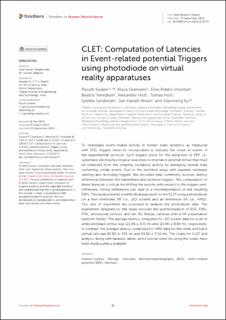| dc.contributor.author | Swami, Piyush | |
| dc.contributor.author | Gramann, Klaus | |
| dc.contributor.author | Vonstad, Elise Klæbo | |
| dc.contributor.author | Vereijken, Beatrix | |
| dc.contributor.author | Holt, Alexander | |
| dc.contributor.author | Holt, Tomas | |
| dc.contributor.author | Sandstrak, Grethe | |
| dc.contributor.author | Nilsen, Jan Harald | |
| dc.contributor.author | Su, Xiaomeng | |
| dc.date.accessioned | 2024-03-19T12:19:24Z | |
| dc.date.available | 2024-03-19T12:19:24Z | |
| dc.date.created | 2023-10-19T14:21:38Z | |
| dc.date.issued | 2023 | |
| dc.identifier.citation | Frontiers in Human Neuroscience. 2023, 17 . | en_US |
| dc.identifier.issn | 1662-5161 | |
| dc.identifier.uri | https://hdl.handle.net/11250/3123114 | |
| dc.description.abstract | Introduction: Most spinal cord injuries (SCI) result in lower extremities paralysis, thus diminishing ambulation. Using brain-computer interfaces (BCI), patients may regain leg control using neural signals that actuate assistive devices. Here, we present a case of a subject with cervical SCI with an implanted electrocorticography (ECoG) device and determined whether the system is capable of motor-imagery-initiated walking in an assistive ambulator.
Methods: A 24-year-old male subject with cervical SCI (C5 ASIA A) was implanted before the study with an ECoG sensing device over the sensorimotor hand region of the brain. The subject used motor-imagery (MI) to train decoders to classify sensorimotor rhythms. Fifteen sessions of closed-loop trials followed in which the subject ambulated for one hour on a robotic-assisted weight-supported treadmill one to three times per week. We evaluated the stability of the best-performing decoder over time to initiate walking on the treadmill by decoding upper-limb (UL) MI.
Results: An online bagged trees classifier performed best with an accuracy of 84.15% averaged across 9 weeks. Decoder accuracy remained stable following throughout closed-loop data collection.
Discussion: These results demonstrate that decoding UL MI is a feasible control signal for use in lower-limb motor control. Invasive BCI systems designed for upper-extremity motor control can be extended for controlling systems beyond upper extremity control alone. Importantly, the decoders used were able to use the invasive signal over several weeks to accurately classify MI from the invasive signal. More work is needed to determine the long-term consequence between UL MI and the resulting lower-limb control. | en_US |
| dc.language.iso | eng | en_US |
| dc.publisher | Frontiers Media | en_US |
| dc.rights | Navngivelse 4.0 Internasjonal | * |
| dc.rights.uri | http://creativecommons.org/licenses/by/4.0/deed.no | * |
| dc.title | CLET: Computation of Latencies in Event-related potential Triggers using photodiode on virtual reality apparatuses | en_US |
| dc.title.alternative | CLET: Computation of Latencies in Event-related potential Triggers using photodiode on virtual reality apparatuses | en_US |
| dc.type | Journal article | en_US |
| dc.type | Peer reviewed | en_US |
| dc.description.version | publishedVersion | en_US |
| dc.source.volume | 17 | en_US |
| dc.source.journal | Frontiers in Human Neuroscience | en_US |
| dc.identifier.doi | 10.3389/fnhum.2023.1223774 | |
| dc.identifier.cristin | 2186425 | |
| cristin.ispublished | true | |
| cristin.fulltext | original | |
| cristin.qualitycode | 1 | |

